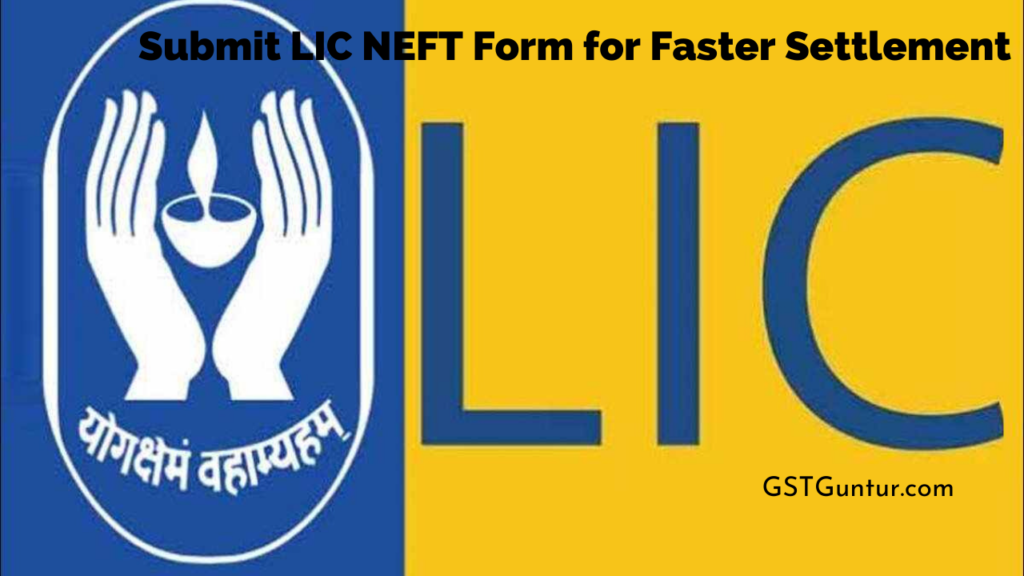Submit LIC NEFT Form for Faster Settlement: For ensuring faster credit of the policy money with higher privacy and security, L.I.C. India assures creating all the payments, including the Maturity, Survival benefits, Loan, Pension payments, surrenders, group schemes, etc., to direct the bank account of the beneficiary or the policyholder. All the valued policyholders, annuitants, claimants, and master policyholders are advised to provide their bank account details after downloading the policy e-payments NEFT mandate or the P&GS mandate form.
This article contains a brief description of the NEFT form of LIC, its advantages, the advantages of using this form, and other details.
LIC NEFT
For ensuring a faster credit of the policy money with extended privacy and security, L.I.C India creates all the payments directly to the bank account of the beneficiary or the policyholder. This became effective from 11th October 2011 and is following the Indian government’s transparency drive. You must submit the NEFT mandate along with the required enclosures for settling the payments under your LIC policy via NEFT. LIC will not settle the payment of the policy in other payment modes like a cheque.
Furthermore, the annuitants, policyholders, master policyholders, and the claimants must provide the bank account details after downloading the policy e-payments NEFT mandate form or the Pension and Group Scheme (P&GS) mandate form. The wholly filled mandate forms must be submitted to the branch office that serves at least one of the policies listed in the mandate. The P&GS master beneficiaries, policyholders, or the annuitants must complete the mandate form and then hand it over to the servicing unit of P&GS.
Submission of LIC NEFT
Before the submission of the LIC NEFT form, you must check the following:
- The account of the annuitant or the policyholder must be operational at the time of the policy payment’s receipt.
- The name of the claimants or the policyholders under the policy must match the name mentioned on the bank account; else, it will be rejected.
- Before the mandate form’s submission, the claimant or the policyholder must confirm that it is NEFT enabled from the bank.
- The FEMA regulations guide the NRI accounts. LIC decided to exclude the NRI accounts for the fund transfers. Therefore, the policyholders and the annuitants must not submit the details of their NRI account.
- After submitting all the NEFT details, if any changes occur in the bank details, then fresher mandate forms must be submitted.
Suppose you receive the annuity payments via ESC mode. In that case, you must choose the payments by NEFT after submitting the mandate or continue receiving the annuity payments in the existing ECS mode.
One mandate or NEFT form is used for over six different policy numbers of the same policyholder.
- All the details mentioned in the enclosed mandate form must be precisely filled with care.
- The completed mandate for NEFT must be sent over to the LIC branch, and it must serve at least one of the policies listed in the mandate.
- The claimant or the policyholder must also submit a cancelled blank cheque leaf with the name and the account number printed over it. If the cheque leaf does not have the printed name and account number, then a photocopy of the passbook’s front page where all the bank account details are mentioned must be submitted along with the cancelled cheque leaf.
- If the bank account does not get the credited amount within two days of the due date, you must contact the branch where you submitted the NEFT mandate.
- After submitting the NEFT mandate, you will receive an SMS or an email from LIC about the NEFT updation.
The NEFT mandate form can be downloaded from the LIC website. It requires the bank details and the IFSC code, the policy number, email and the mobile number. It must be attached with the cancelled cheque leaf before sending it to the serving branch.
NEFT
NEFT refers to a nationwide system facilitating the transfer of funds from one account of any bank branch to another bank branch account. RTGS or NEFT is used for fund transfers to other banks. The Reserve Bank of India (RBI) operates the system. Almost all the banks across India support NEFT, but you can still confirm it with your branch and bank at the official website of RBI.
Speed appears to be the most significant benefit of electronic fund transfers, mainly the Real-Time Gross Settlement (RTGS) or the National Electronic Fund Transfer (NEFT). For a cheque, it usually requires 2 to 3 days to get clear. However, in the case of electronic transfers, money gets transferred directly from the sender’s bank account or the remitter’s bank account to the receiver’s bank account on the same day. There are no added costs for receiving the funds to any bank account via NEFT, but some minimal charges are applied if you transfer funds from your account.
Advantages of NEFT for the Policyholders or the Annuitants
- The claimant or the policyholder will receive credits in his account on the payment due date despite the location of his bank.
- NEFT also ensures a faster and secure payment mode.
- No extra charges apply to the claimant or the policyholders.
- Email and SMS alerts might be provided wherever the policy payment is made to the claimant’s account or the policyholder through NEFT.
- Each LIC payment done through NEFT will create a Unique Transaction Reference (UTR) Number. If any problem occurs in credit to the account of the claimant or the policyholder, he/she can confirm the bank by quoting this received UTR number. Thus, it becomes effortless to track any transaction of NEFT using this UTR number.
